Marketing Report: Consumer Behavior, Porter's 5 Forces, Brand Analysis
VerifiedAdded on 2023/01/04
|11
|3082
|59
Report
AI Summary
This report presents a comprehensive marketing analysis of the Nissan and Geely brands within the automobile industry. It begins by exploring the consumer decision-making process relevant to car purchases, examining factors like need identification, research, evaluation, and purchase decisions. The report then applies Porter's Five Forces framework to assess the competitive landscape for Nissan, analyzing the bargaining power of buyers and suppliers, the threat of new entrants and substitutes, and competitive rivalry. Furthermore, the report develops and discusses the application of GE Matrix and BCG Matrix to evaluate the strategic positioning of Nissan and Geely's various business units. Finally, it outlines segmentation, targeting, and positioning strategies employed within the automobile sector, providing a holistic view of the marketing challenges and opportunities faced by these brands.
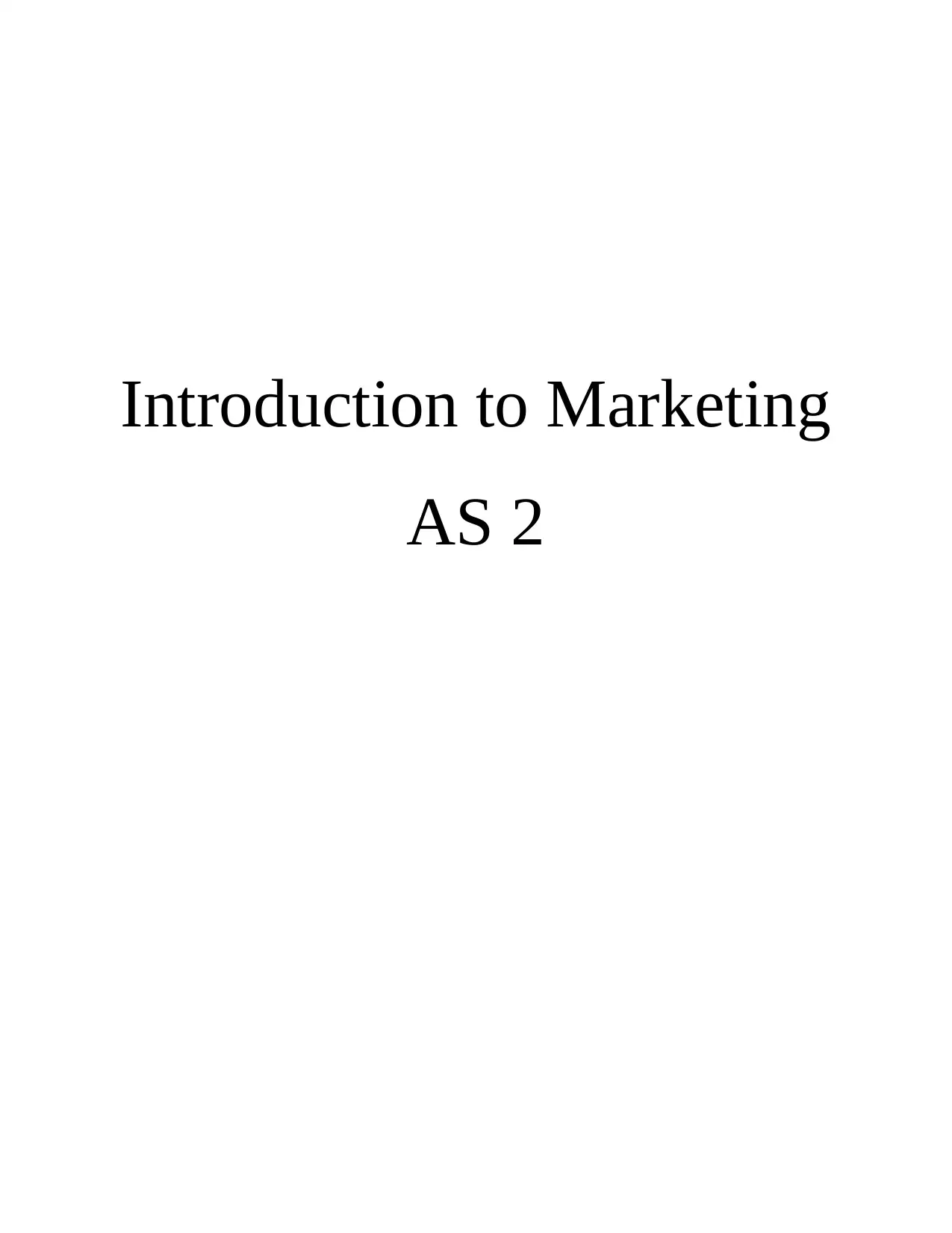
Introduction to Marketing
AS 2
AS 2
Paraphrase This Document
Need a fresh take? Get an instant paraphrase of this document with our AI Paraphraser
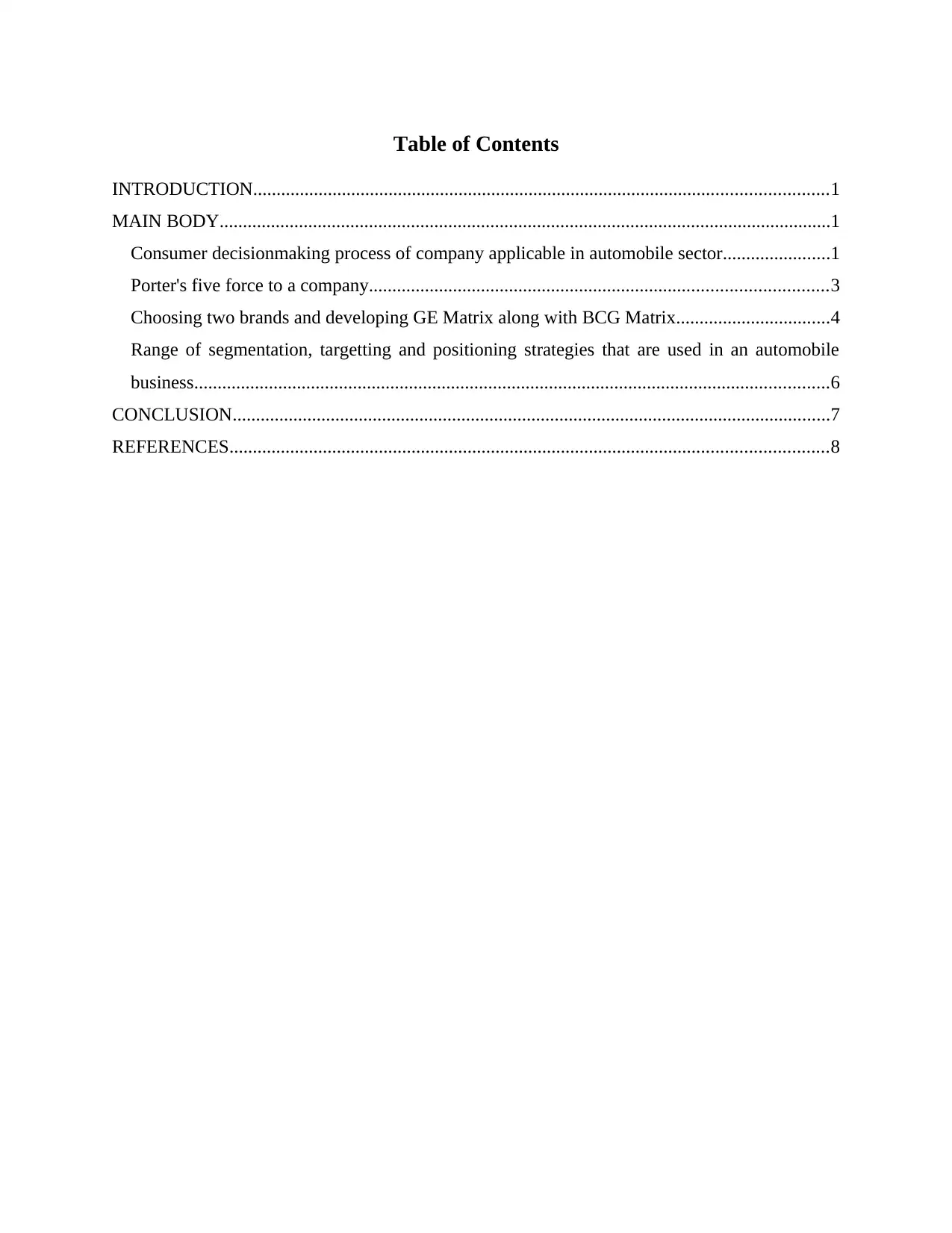
Table of Contents
INTRODUCTION...........................................................................................................................1
MAIN BODY...................................................................................................................................1
Consumer decisionmaking process of company applicable in automobile sector.......................1
Porter's five force to a company..................................................................................................3
Choosing two brands and developing GE Matrix along with BCG Matrix.................................4
Range of segmentation, targetting and positioning strategies that are used in an automobile
business........................................................................................................................................6
CONCLUSION................................................................................................................................7
REFERENCES................................................................................................................................8
INTRODUCTION...........................................................................................................................1
MAIN BODY...................................................................................................................................1
Consumer decisionmaking process of company applicable in automobile sector.......................1
Porter's five force to a company..................................................................................................3
Choosing two brands and developing GE Matrix along with BCG Matrix.................................4
Range of segmentation, targetting and positioning strategies that are used in an automobile
business........................................................................................................................................6
CONCLUSION................................................................................................................................7
REFERENCES................................................................................................................................8

⊘ This is a preview!⊘
Do you want full access?
Subscribe today to unlock all pages.

Trusted by 1+ million students worldwide
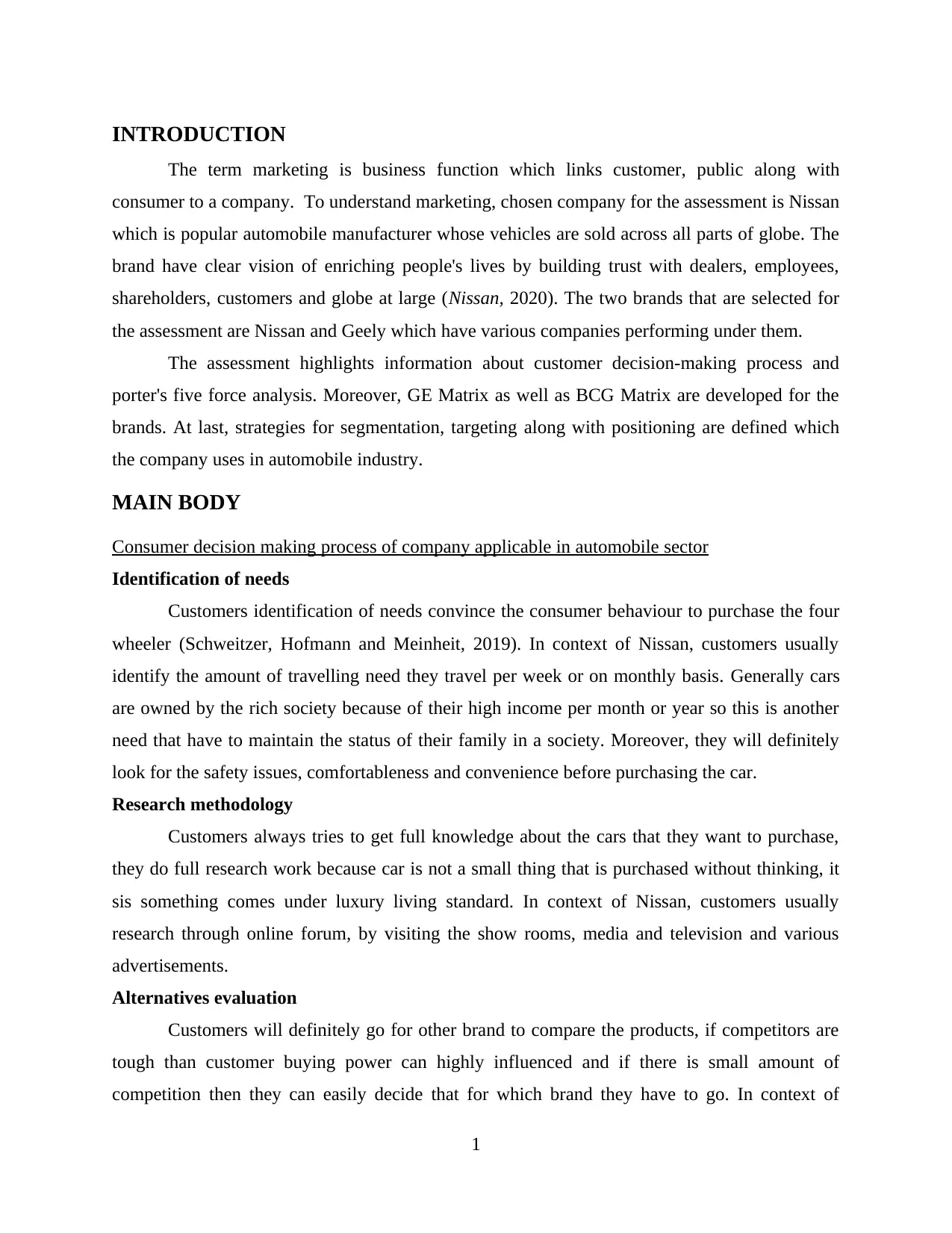
INTRODUCTION
The term marketing is business function which links customer, public along with
consumer to a company. To understand marketing, chosen company for the assessment is Nissan
which is popular automobile manufacturer whose vehicles are sold across all parts of globe. The
brand have clear vision of enriching people's lives by building trust with dealers, employees,
shareholders, customers and globe at large (Nissan, 2020). The two brands that are selected for
the assessment are Nissan and Geely which have various companies performing under them.
The assessment highlights information about customer decision-making process and
porter's five force analysis. Moreover, GE Matrix as well as BCG Matrix are developed for the
brands. At last, strategies for segmentation, targeting along with positioning are defined which
the company uses in automobile industry.
MAIN BODY
Consumer decision making process of company applicable in automobile sector
Identification of needs
Customers identification of needs convince the consumer behaviour to purchase the four
wheeler (Schweitzer, Hofmann and Meinheit, 2019). In context of Nissan, customers usually
identify the amount of travelling need they travel per week or on monthly basis. Generally cars
are owned by the rich society because of their high income per month or year so this is another
need that have to maintain the status of their family in a society. Moreover, they will definitely
look for the safety issues, comfortableness and convenience before purchasing the car.
Research methodology
Customers always tries to get full knowledge about the cars that they want to purchase,
they do full research work because car is not a small thing that is purchased without thinking, it
sis something comes under luxury living standard. In context of Nissan, customers usually
research through online forum, by visiting the show rooms, media and television and various
advertisements.
Alternatives evaluation
Customers will definitely go for other brand to compare the products, if competitors are
tough than customer buying power can highly influenced and if there is small amount of
competition then they can easily decide that for which brand they have to go. In context of
1
The term marketing is business function which links customer, public along with
consumer to a company. To understand marketing, chosen company for the assessment is Nissan
which is popular automobile manufacturer whose vehicles are sold across all parts of globe. The
brand have clear vision of enriching people's lives by building trust with dealers, employees,
shareholders, customers and globe at large (Nissan, 2020). The two brands that are selected for
the assessment are Nissan and Geely which have various companies performing under them.
The assessment highlights information about customer decision-making process and
porter's five force analysis. Moreover, GE Matrix as well as BCG Matrix are developed for the
brands. At last, strategies for segmentation, targeting along with positioning are defined which
the company uses in automobile industry.
MAIN BODY
Consumer decision making process of company applicable in automobile sector
Identification of needs
Customers identification of needs convince the consumer behaviour to purchase the four
wheeler (Schweitzer, Hofmann and Meinheit, 2019). In context of Nissan, customers usually
identify the amount of travelling need they travel per week or on monthly basis. Generally cars
are owned by the rich society because of their high income per month or year so this is another
need that have to maintain the status of their family in a society. Moreover, they will definitely
look for the safety issues, comfortableness and convenience before purchasing the car.
Research methodology
Customers always tries to get full knowledge about the cars that they want to purchase,
they do full research work because car is not a small thing that is purchased without thinking, it
sis something comes under luxury living standard. In context of Nissan, customers usually
research through online forum, by visiting the show rooms, media and television and various
advertisements.
Alternatives evaluation
Customers will definitely go for other brand to compare the products, if competitors are
tough than customer buying power can highly influenced and if there is small amount of
competition then they can easily decide that for which brand they have to go. In context of
1
Paraphrase This Document
Need a fresh take? Get an instant paraphrase of this document with our AI Paraphraser
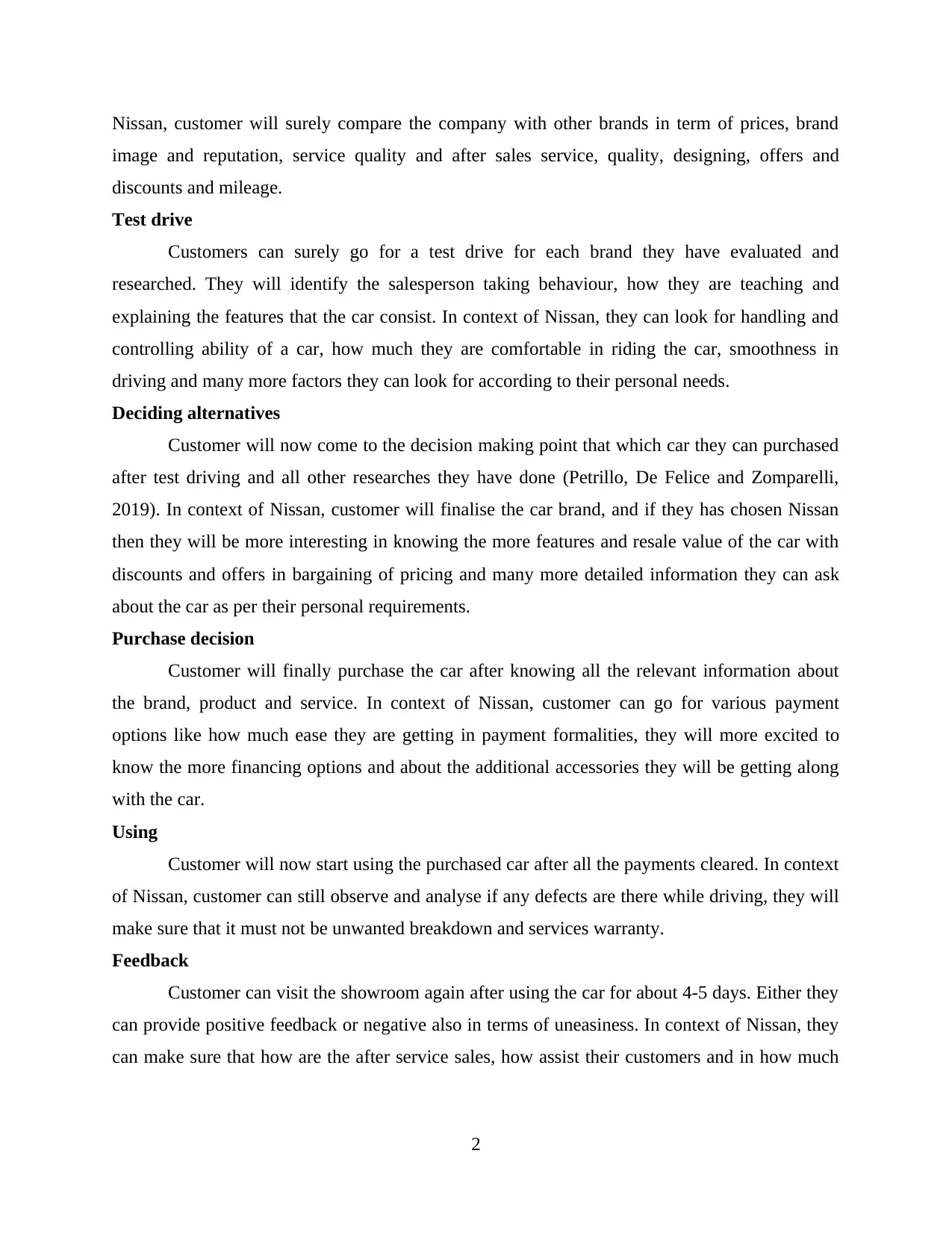
Nissan, customer will surely compare the company with other brands in term of prices, brand
image and reputation, service quality and after sales service, quality, designing, offers and
discounts and mileage.
Test drive
Customers can surely go for a test drive for each brand they have evaluated and
researched. They will identify the salesperson taking behaviour, how they are teaching and
explaining the features that the car consist. In context of Nissan, they can look for handling and
controlling ability of a car, how much they are comfortable in riding the car, smoothness in
driving and many more factors they can look for according to their personal needs.
Deciding alternatives
Customer will now come to the decision making point that which car they can purchased
after test driving and all other researches they have done (Petrillo, De Felice and Zomparelli,
2019). In context of Nissan, customer will finalise the car brand, and if they has chosen Nissan
then they will be more interesting in knowing the more features and resale value of the car with
discounts and offers in bargaining of pricing and many more detailed information they can ask
about the car as per their personal requirements.
Purchase decision
Customer will finally purchase the car after knowing all the relevant information about
the brand, product and service. In context of Nissan, customer can go for various payment
options like how much ease they are getting in payment formalities, they will more excited to
know the more financing options and about the additional accessories they will be getting along
with the car.
Using
Customer will now start using the purchased car after all the payments cleared. In context
of Nissan, customer can still observe and analyse if any defects are there while driving, they will
make sure that it must not be unwanted breakdown and services warranty.
Feedback
Customer can visit the showroom again after using the car for about 4-5 days. Either they
can provide positive feedback or negative also in terms of uneasiness. In context of Nissan, they
can make sure that how are the after service sales, how assist their customers and in how much
2
image and reputation, service quality and after sales service, quality, designing, offers and
discounts and mileage.
Test drive
Customers can surely go for a test drive for each brand they have evaluated and
researched. They will identify the salesperson taking behaviour, how they are teaching and
explaining the features that the car consist. In context of Nissan, they can look for handling and
controlling ability of a car, how much they are comfortable in riding the car, smoothness in
driving and many more factors they can look for according to their personal needs.
Deciding alternatives
Customer will now come to the decision making point that which car they can purchased
after test driving and all other researches they have done (Petrillo, De Felice and Zomparelli,
2019). In context of Nissan, customer will finalise the car brand, and if they has chosen Nissan
then they will be more interesting in knowing the more features and resale value of the car with
discounts and offers in bargaining of pricing and many more detailed information they can ask
about the car as per their personal requirements.
Purchase decision
Customer will finally purchase the car after knowing all the relevant information about
the brand, product and service. In context of Nissan, customer can go for various payment
options like how much ease they are getting in payment formalities, they will more excited to
know the more financing options and about the additional accessories they will be getting along
with the car.
Using
Customer will now start using the purchased car after all the payments cleared. In context
of Nissan, customer can still observe and analyse if any defects are there while driving, they will
make sure that it must not be unwanted breakdown and services warranty.
Feedback
Customer can visit the showroom again after using the car for about 4-5 days. Either they
can provide positive feedback or negative also in terms of uneasiness. In context of Nissan, they
can make sure that how are the after service sales, how assist their customers and in how much
2
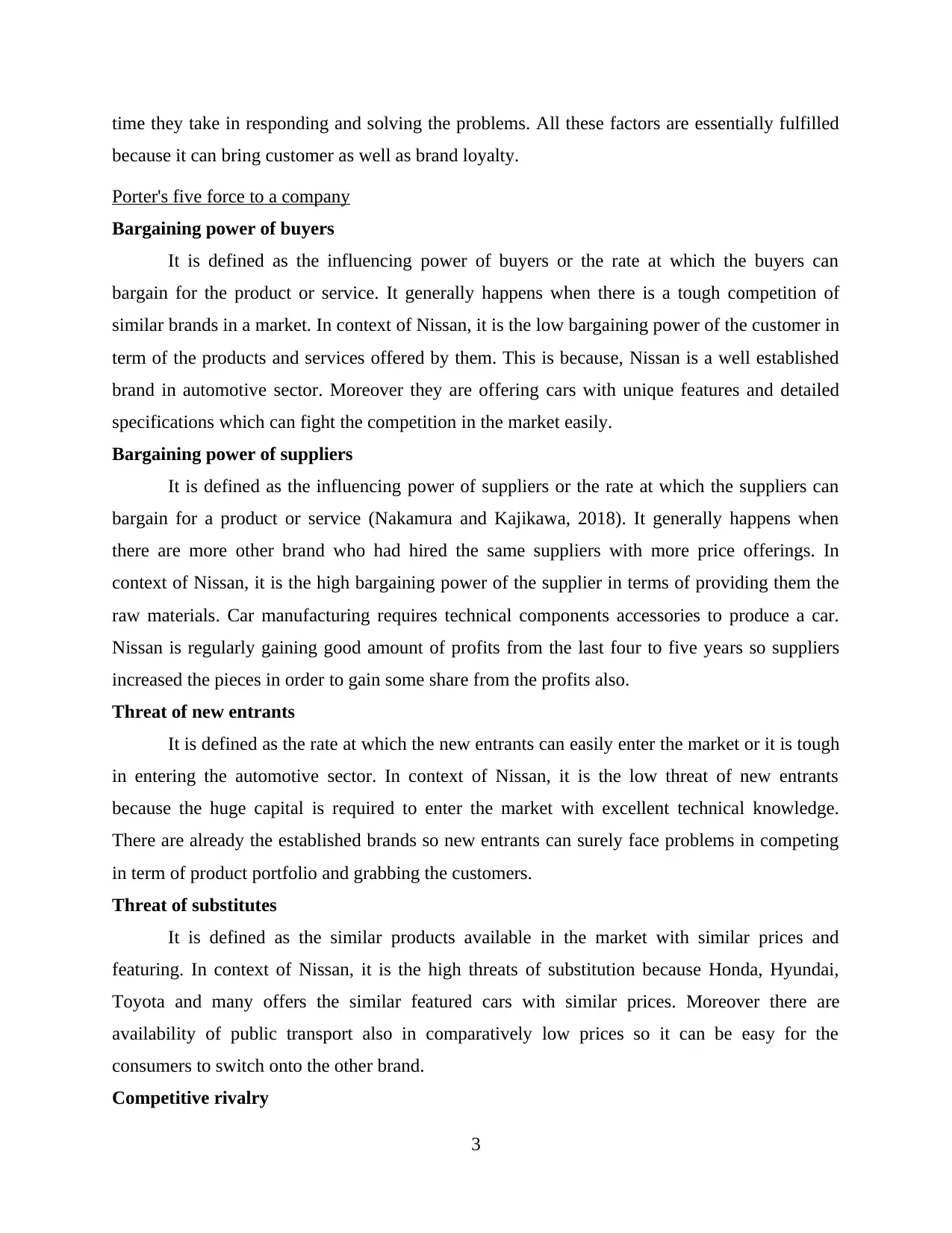
time they take in responding and solving the problems. All these factors are essentially fulfilled
because it can bring customer as well as brand loyalty.
Porter's five force to a company
Bargaining power of buyers
It is defined as the influencing power of buyers or the rate at which the buyers can
bargain for the product or service. It generally happens when there is a tough competition of
similar brands in a market. In context of Nissan, it is the low bargaining power of the customer in
term of the products and services offered by them. This is because, Nissan is a well established
brand in automotive sector. Moreover they are offering cars with unique features and detailed
specifications which can fight the competition in the market easily.
Bargaining power of suppliers
It is defined as the influencing power of suppliers or the rate at which the suppliers can
bargain for a product or service (Nakamura and Kajikawa, 2018). It generally happens when
there are more other brand who had hired the same suppliers with more price offerings. In
context of Nissan, it is the high bargaining power of the supplier in terms of providing them the
raw materials. Car manufacturing requires technical components accessories to produce a car.
Nissan is regularly gaining good amount of profits from the last four to five years so suppliers
increased the pieces in order to gain some share from the profits also.
Threat of new entrants
It is defined as the rate at which the new entrants can easily enter the market or it is tough
in entering the automotive sector. In context of Nissan, it is the low threat of new entrants
because the huge capital is required to enter the market with excellent technical knowledge.
There are already the established brands so new entrants can surely face problems in competing
in term of product portfolio and grabbing the customers.
Threat of substitutes
It is defined as the similar products available in the market with similar prices and
featuring. In context of Nissan, it is the high threats of substitution because Honda, Hyundai,
Toyota and many offers the similar featured cars with similar prices. Moreover there are
availability of public transport also in comparatively low prices so it can be easy for the
consumers to switch onto the other brand.
Competitive rivalry
3
because it can bring customer as well as brand loyalty.
Porter's five force to a company
Bargaining power of buyers
It is defined as the influencing power of buyers or the rate at which the buyers can
bargain for the product or service. It generally happens when there is a tough competition of
similar brands in a market. In context of Nissan, it is the low bargaining power of the customer in
term of the products and services offered by them. This is because, Nissan is a well established
brand in automotive sector. Moreover they are offering cars with unique features and detailed
specifications which can fight the competition in the market easily.
Bargaining power of suppliers
It is defined as the influencing power of suppliers or the rate at which the suppliers can
bargain for a product or service (Nakamura and Kajikawa, 2018). It generally happens when
there are more other brand who had hired the same suppliers with more price offerings. In
context of Nissan, it is the high bargaining power of the supplier in terms of providing them the
raw materials. Car manufacturing requires technical components accessories to produce a car.
Nissan is regularly gaining good amount of profits from the last four to five years so suppliers
increased the pieces in order to gain some share from the profits also.
Threat of new entrants
It is defined as the rate at which the new entrants can easily enter the market or it is tough
in entering the automotive sector. In context of Nissan, it is the low threat of new entrants
because the huge capital is required to enter the market with excellent technical knowledge.
There are already the established brands so new entrants can surely face problems in competing
in term of product portfolio and grabbing the customers.
Threat of substitutes
It is defined as the similar products available in the market with similar prices and
featuring. In context of Nissan, it is the high threats of substitution because Honda, Hyundai,
Toyota and many offers the similar featured cars with similar prices. Moreover there are
availability of public transport also in comparatively low prices so it can be easy for the
consumers to switch onto the other brand.
Competitive rivalry
3
⊘ This is a preview!⊘
Do you want full access?
Subscribe today to unlock all pages.

Trusted by 1+ million students worldwide
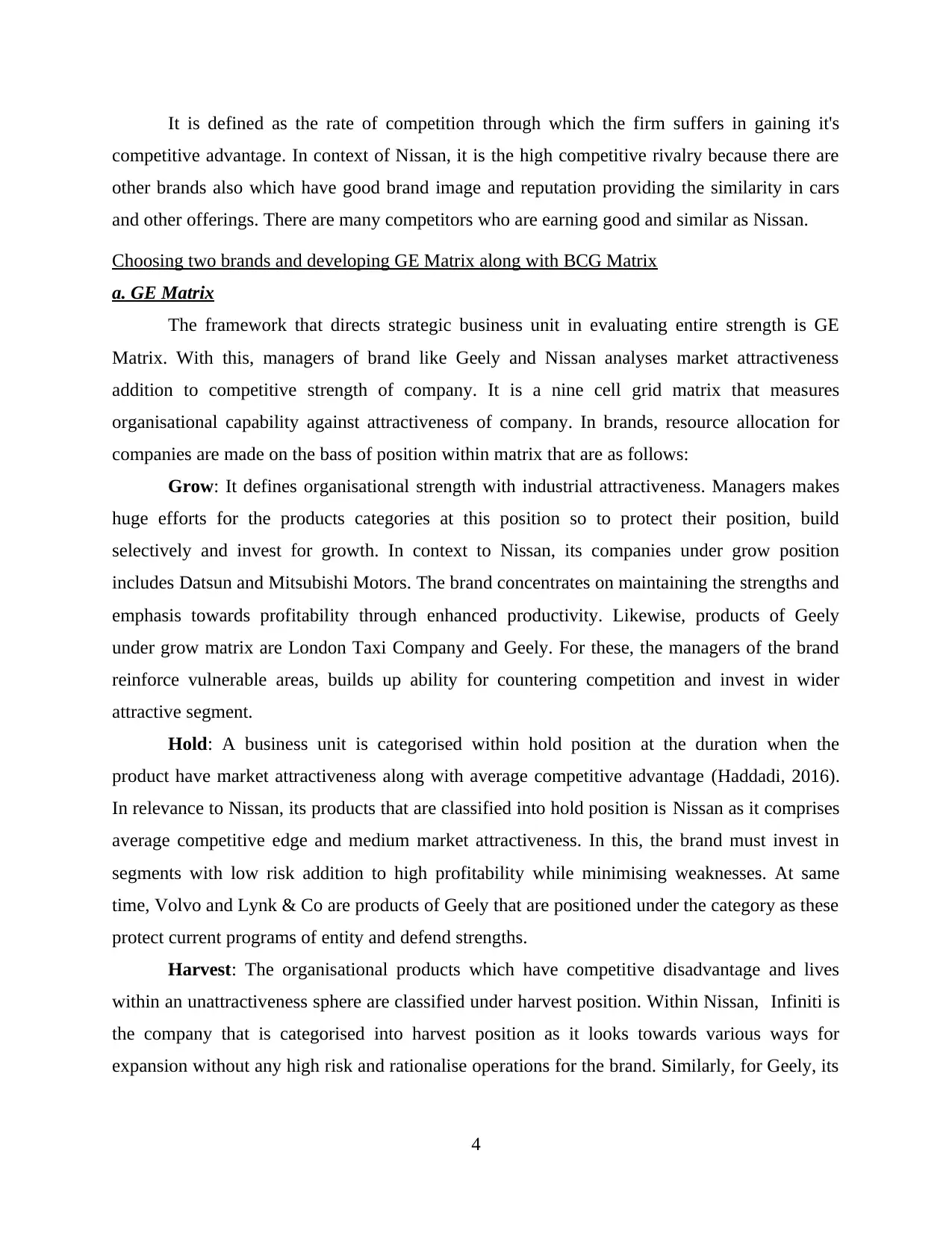
It is defined as the rate of competition through which the firm suffers in gaining it's
competitive advantage. In context of Nissan, it is the high competitive rivalry because there are
other brands also which have good brand image and reputation providing the similarity in cars
and other offerings. There are many competitors who are earning good and similar as Nissan.
Choosing two brands and developing GE Matrix along with BCG Matrix
a. GE Matrix
The framework that directs strategic business unit in evaluating entire strength is GE
Matrix. With this, managers of brand like Geely and Nissan analyses market attractiveness
addition to competitive strength of company. It is a nine cell grid matrix that measures
organisational capability against attractiveness of company. In brands, resource allocation for
companies are made on the bass of position within matrix that are as follows:
Grow: It defines organisational strength with industrial attractiveness. Managers makes
huge efforts for the products categories at this position so to protect their position, build
selectively and invest for growth. In context to Nissan, its companies under grow position
includes Datsun and Mitsubishi Motors. The brand concentrates on maintaining the strengths and
emphasis towards profitability through enhanced productivity. Likewise, products of Geely
under grow matrix are London Taxi Company and Geely. For these, the managers of the brand
reinforce vulnerable areas, builds up ability for countering competition and invest in wider
attractive segment.
Hold: A business unit is categorised within hold position at the duration when the
product have market attractiveness along with average competitive advantage (Haddadi, 2016).
In relevance to Nissan, its products that are classified into hold position is Nissan as it comprises
average competitive edge and medium market attractiveness. In this, the brand must invest in
segments with low risk addition to high profitability while minimising weaknesses. At same
time, Volvo and Lynk & Co are products of Geely that are positioned under the category as these
protect current programs of entity and defend strengths.
Harvest: The organisational products which have competitive disadvantage and lives
within an unattractiveness sphere are classified under harvest position. Within Nissan, Infiniti is
the company that is categorised into harvest position as it looks towards various ways for
expansion without any high risk and rationalise operations for the brand. Similarly, for Geely, its
4
competitive advantage. In context of Nissan, it is the high competitive rivalry because there are
other brands also which have good brand image and reputation providing the similarity in cars
and other offerings. There are many competitors who are earning good and similar as Nissan.
Choosing two brands and developing GE Matrix along with BCG Matrix
a. GE Matrix
The framework that directs strategic business unit in evaluating entire strength is GE
Matrix. With this, managers of brand like Geely and Nissan analyses market attractiveness
addition to competitive strength of company. It is a nine cell grid matrix that measures
organisational capability against attractiveness of company. In brands, resource allocation for
companies are made on the bass of position within matrix that are as follows:
Grow: It defines organisational strength with industrial attractiveness. Managers makes
huge efforts for the products categories at this position so to protect their position, build
selectively and invest for growth. In context to Nissan, its companies under grow position
includes Datsun and Mitsubishi Motors. The brand concentrates on maintaining the strengths and
emphasis towards profitability through enhanced productivity. Likewise, products of Geely
under grow matrix are London Taxi Company and Geely. For these, the managers of the brand
reinforce vulnerable areas, builds up ability for countering competition and invest in wider
attractive segment.
Hold: A business unit is categorised within hold position at the duration when the
product have market attractiveness along with average competitive advantage (Haddadi, 2016).
In relevance to Nissan, its products that are classified into hold position is Nissan as it comprises
average competitive edge and medium market attractiveness. In this, the brand must invest in
segments with low risk addition to high profitability while minimising weaknesses. At same
time, Volvo and Lynk & Co are products of Geely that are positioned under the category as these
protect current programs of entity and defend strengths.
Harvest: The organisational products which have competitive disadvantage and lives
within an unattractiveness sphere are classified under harvest position. Within Nissan, Infiniti is
the company that is categorised into harvest position as it looks towards various ways for
expansion without any high risk and rationalise operations for the brand. Similarly, for Geely, its
4
Paraphrase This Document
Need a fresh take? Get an instant paraphrase of this document with our AI Paraphraser
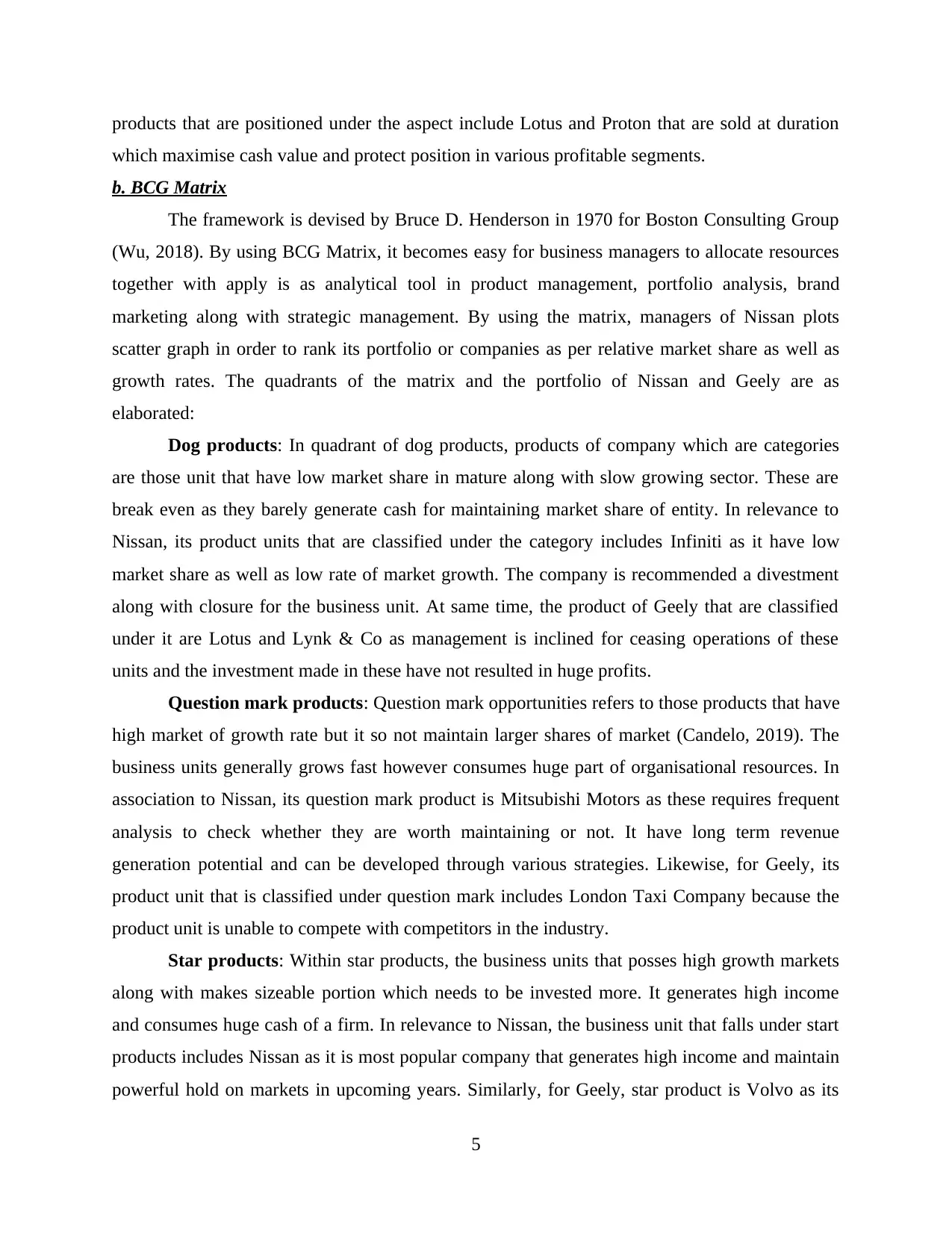
products that are positioned under the aspect include Lotus and Proton that are sold at duration
which maximise cash value and protect position in various profitable segments.
b. BCG Matrix
The framework is devised by Bruce D. Henderson in 1970 for Boston Consulting Group
(Wu, 2018). By using BCG Matrix, it becomes easy for business managers to allocate resources
together with apply is as analytical tool in product management, portfolio analysis, brand
marketing along with strategic management. By using the matrix, managers of Nissan plots
scatter graph in order to rank its portfolio or companies as per relative market share as well as
growth rates. The quadrants of the matrix and the portfolio of Nissan and Geely are as
elaborated:
Dog products: In quadrant of dog products, products of company which are categories
are those unit that have low market share in mature along with slow growing sector. These are
break even as they barely generate cash for maintaining market share of entity. In relevance to
Nissan, its product units that are classified under the category includes Infiniti as it have low
market share as well as low rate of market growth. The company is recommended a divestment
along with closure for the business unit. At same time, the product of Geely that are classified
under it are Lotus and Lynk & Co as management is inclined for ceasing operations of these
units and the investment made in these have not resulted in huge profits.
Question mark products: Question mark opportunities refers to those products that have
high market of growth rate but it so not maintain larger shares of market (Candelo, 2019). The
business units generally grows fast however consumes huge part of organisational resources. In
association to Nissan, its question mark product is Mitsubishi Motors as these requires frequent
analysis to check whether they are worth maintaining or not. It have long term revenue
generation potential and can be developed through various strategies. Likewise, for Geely, its
product unit that is classified under question mark includes London Taxi Company because the
product unit is unable to compete with competitors in the industry.
Star products: Within star products, the business units that posses high growth markets
along with makes sizeable portion which needs to be invested more. It generates high income
and consumes huge cash of a firm. In relevance to Nissan, the business unit that falls under start
products includes Nissan as it is most popular company that generates high income and maintain
powerful hold on markets in upcoming years. Similarly, for Geely, star product is Volvo as its
5
which maximise cash value and protect position in various profitable segments.
b. BCG Matrix
The framework is devised by Bruce D. Henderson in 1970 for Boston Consulting Group
(Wu, 2018). By using BCG Matrix, it becomes easy for business managers to allocate resources
together with apply is as analytical tool in product management, portfolio analysis, brand
marketing along with strategic management. By using the matrix, managers of Nissan plots
scatter graph in order to rank its portfolio or companies as per relative market share as well as
growth rates. The quadrants of the matrix and the portfolio of Nissan and Geely are as
elaborated:
Dog products: In quadrant of dog products, products of company which are categories
are those unit that have low market share in mature along with slow growing sector. These are
break even as they barely generate cash for maintaining market share of entity. In relevance to
Nissan, its product units that are classified under the category includes Infiniti as it have low
market share as well as low rate of market growth. The company is recommended a divestment
along with closure for the business unit. At same time, the product of Geely that are classified
under it are Lotus and Lynk & Co as management is inclined for ceasing operations of these
units and the investment made in these have not resulted in huge profits.
Question mark products: Question mark opportunities refers to those products that have
high market of growth rate but it so not maintain larger shares of market (Candelo, 2019). The
business units generally grows fast however consumes huge part of organisational resources. In
association to Nissan, its question mark product is Mitsubishi Motors as these requires frequent
analysis to check whether they are worth maintaining or not. It have long term revenue
generation potential and can be developed through various strategies. Likewise, for Geely, its
product unit that is classified under question mark includes London Taxi Company because the
product unit is unable to compete with competitors in the industry.
Star products: Within star products, the business units that posses high growth markets
along with makes sizeable portion which needs to be invested more. It generates high income
and consumes huge cash of a firm. In relevance to Nissan, the business unit that falls under start
products includes Nissan as it is most popular company that generates high income and maintain
powerful hold on markets in upcoming years. Similarly, for Geely, star product is Volvo as its
5
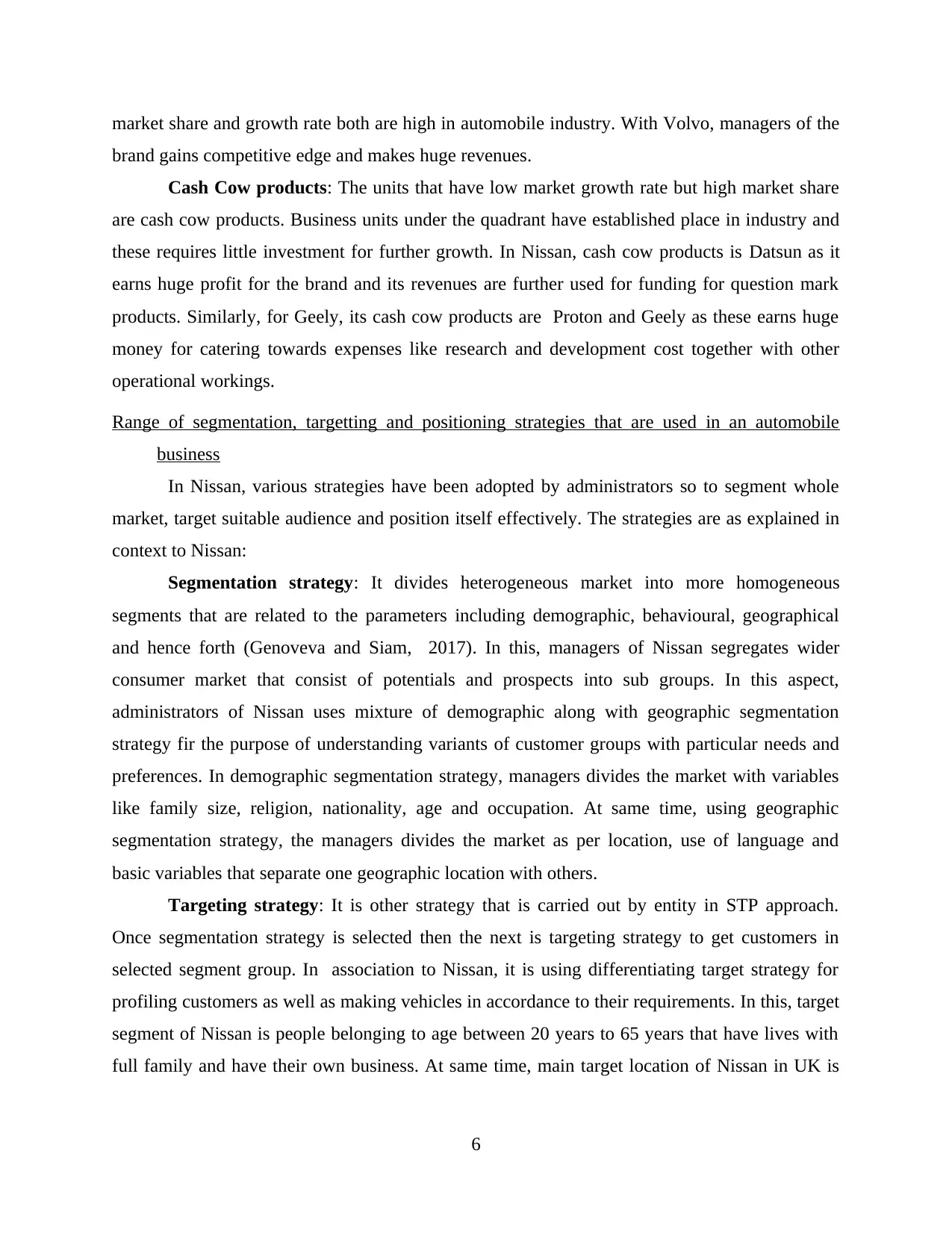
market share and growth rate both are high in automobile industry. With Volvo, managers of the
brand gains competitive edge and makes huge revenues.
Cash Cow products: The units that have low market growth rate but high market share
are cash cow products. Business units under the quadrant have established place in industry and
these requires little investment for further growth. In Nissan, cash cow products is Datsun as it
earns huge profit for the brand and its revenues are further used for funding for question mark
products. Similarly, for Geely, its cash cow products are Proton and Geely as these earns huge
money for catering towards expenses like research and development cost together with other
operational workings.
Range of segmentation, targetting and positioning strategies that are used in an automobile
business
In Nissan, various strategies have been adopted by administrators so to segment whole
market, target suitable audience and position itself effectively. The strategies are as explained in
context to Nissan:
Segmentation strategy: It divides heterogeneous market into more homogeneous
segments that are related to the parameters including demographic, behavioural, geographical
and hence forth (Genoveva and Siam, 2017). In this, managers of Nissan segregates wider
consumer market that consist of potentials and prospects into sub groups. In this aspect,
administrators of Nissan uses mixture of demographic along with geographic segmentation
strategy fir the purpose of understanding variants of customer groups with particular needs and
preferences. In demographic segmentation strategy, managers divides the market with variables
like family size, religion, nationality, age and occupation. At same time, using geographic
segmentation strategy, the managers divides the market as per location, use of language and
basic variables that separate one geographic location with others.
Targeting strategy: It is other strategy that is carried out by entity in STP approach.
Once segmentation strategy is selected then the next is targeting strategy to get customers in
selected segment group. In association to Nissan, it is using differentiating target strategy for
profiling customers as well as making vehicles in accordance to their requirements. In this, target
segment of Nissan is people belonging to age between 20 years to 65 years that have lives with
full family and have their own business. At same time, main target location of Nissan in UK is
6
brand gains competitive edge and makes huge revenues.
Cash Cow products: The units that have low market growth rate but high market share
are cash cow products. Business units under the quadrant have established place in industry and
these requires little investment for further growth. In Nissan, cash cow products is Datsun as it
earns huge profit for the brand and its revenues are further used for funding for question mark
products. Similarly, for Geely, its cash cow products are Proton and Geely as these earns huge
money for catering towards expenses like research and development cost together with other
operational workings.
Range of segmentation, targetting and positioning strategies that are used in an automobile
business
In Nissan, various strategies have been adopted by administrators so to segment whole
market, target suitable audience and position itself effectively. The strategies are as explained in
context to Nissan:
Segmentation strategy: It divides heterogeneous market into more homogeneous
segments that are related to the parameters including demographic, behavioural, geographical
and hence forth (Genoveva and Siam, 2017). In this, managers of Nissan segregates wider
consumer market that consist of potentials and prospects into sub groups. In this aspect,
administrators of Nissan uses mixture of demographic along with geographic segmentation
strategy fir the purpose of understanding variants of customer groups with particular needs and
preferences. In demographic segmentation strategy, managers divides the market with variables
like family size, religion, nationality, age and occupation. At same time, using geographic
segmentation strategy, the managers divides the market as per location, use of language and
basic variables that separate one geographic location with others.
Targeting strategy: It is other strategy that is carried out by entity in STP approach.
Once segmentation strategy is selected then the next is targeting strategy to get customers in
selected segment group. In association to Nissan, it is using differentiating target strategy for
profiling customers as well as making vehicles in accordance to their requirements. In this, target
segment of Nissan is people belonging to age between 20 years to 65 years that have lives with
full family and have their own business. At same time, main target location of Nissan in UK is
6
⊘ This is a preview!⊘
Do you want full access?
Subscribe today to unlock all pages.

Trusted by 1+ million students worldwide
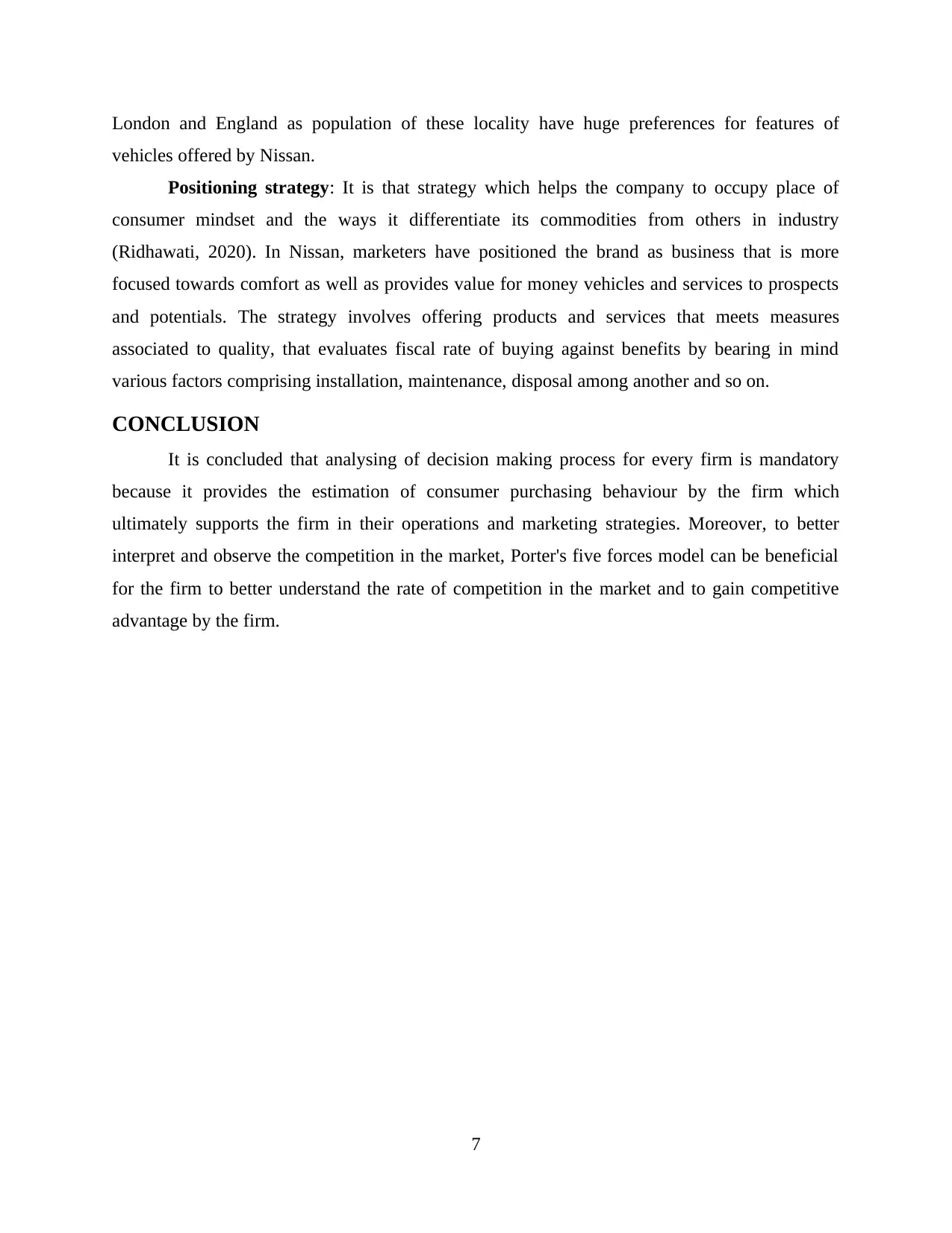
London and England as population of these locality have huge preferences for features of
vehicles offered by Nissan.
Positioning strategy: It is that strategy which helps the company to occupy place of
consumer mindset and the ways it differentiate its commodities from others in industry
(Ridhawati, 2020). In Nissan, marketers have positioned the brand as business that is more
focused towards comfort as well as provides value for money vehicles and services to prospects
and potentials. The strategy involves offering products and services that meets measures
associated to quality, that evaluates fiscal rate of buying against benefits by bearing in mind
various factors comprising installation, maintenance, disposal among another and so on.
CONCLUSION
It is concluded that analysing of decision making process for every firm is mandatory
because it provides the estimation of consumer purchasing behaviour by the firm which
ultimately supports the firm in their operations and marketing strategies. Moreover, to better
interpret and observe the competition in the market, Porter's five forces model can be beneficial
for the firm to better understand the rate of competition in the market and to gain competitive
advantage by the firm.
7
vehicles offered by Nissan.
Positioning strategy: It is that strategy which helps the company to occupy place of
consumer mindset and the ways it differentiate its commodities from others in industry
(Ridhawati, 2020). In Nissan, marketers have positioned the brand as business that is more
focused towards comfort as well as provides value for money vehicles and services to prospects
and potentials. The strategy involves offering products and services that meets measures
associated to quality, that evaluates fiscal rate of buying against benefits by bearing in mind
various factors comprising installation, maintenance, disposal among another and so on.
CONCLUSION
It is concluded that analysing of decision making process for every firm is mandatory
because it provides the estimation of consumer purchasing behaviour by the firm which
ultimately supports the firm in their operations and marketing strategies. Moreover, to better
interpret and observe the competition in the market, Porter's five forces model can be beneficial
for the firm to better understand the rate of competition in the market and to gain competitive
advantage by the firm.
7
Paraphrase This Document
Need a fresh take? Get an instant paraphrase of this document with our AI Paraphraser
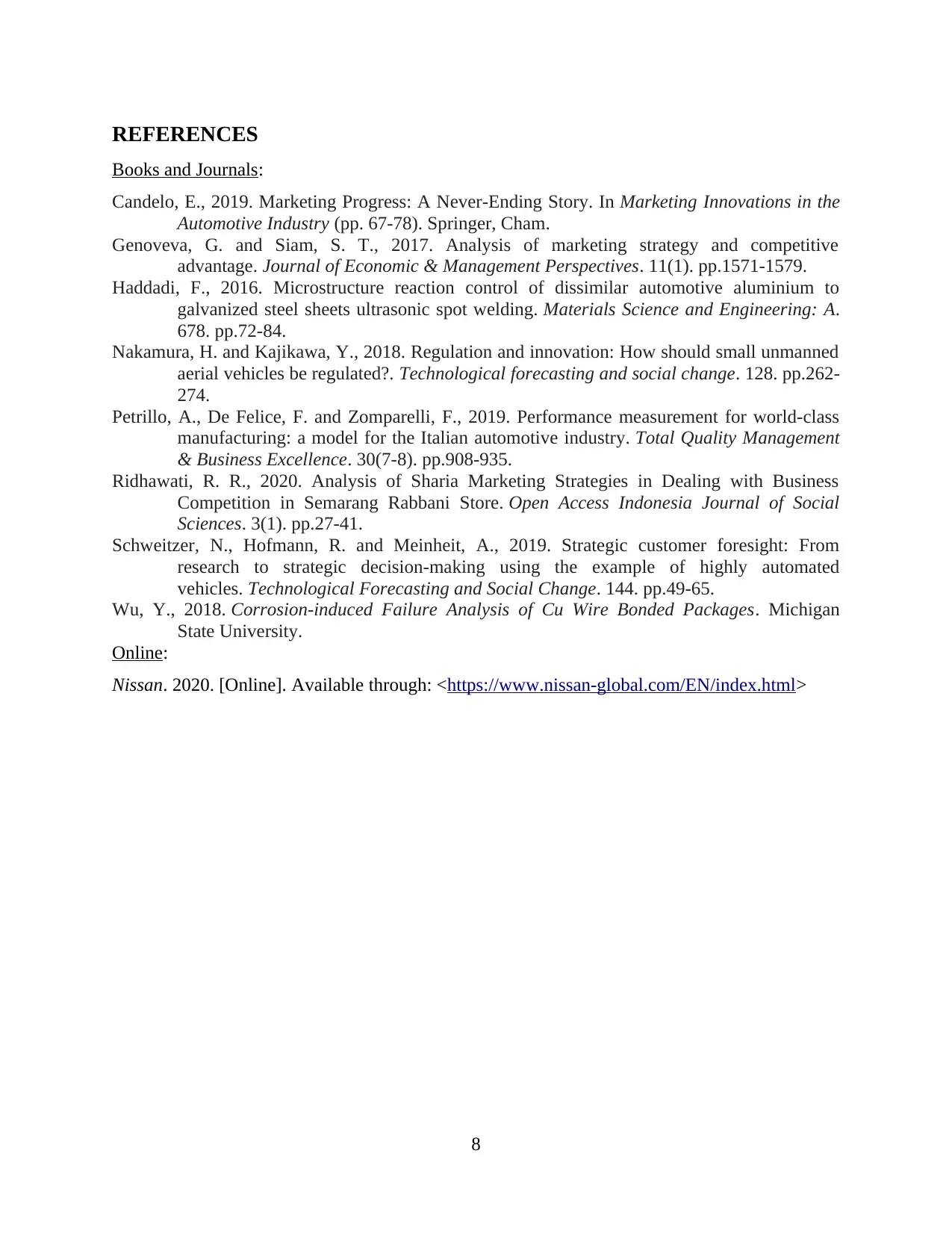
REFERENCES
Books and Journals:
Candelo, E., 2019. Marketing Progress: A Never-Ending Story. In Marketing Innovations in the
Automotive Industry (pp. 67-78). Springer, Cham.
Genoveva, G. and Siam, S. T., 2017. Analysis of marketing strategy and competitive
advantage. Journal of Economic & Management Perspectives. 11(1). pp.1571-1579.
Haddadi, F., 2016. Microstructure reaction control of dissimilar automotive aluminium to
galvanized steel sheets ultrasonic spot welding. Materials Science and Engineering: A.
678. pp.72-84.
Nakamura, H. and Kajikawa, Y., 2018. Regulation and innovation: How should small unmanned
aerial vehicles be regulated?. Technological forecasting and social change. 128. pp.262-
274.
Petrillo, A., De Felice, F. and Zomparelli, F., 2019. Performance measurement for world-class
manufacturing: a model for the Italian automotive industry. Total Quality Management
& Business Excellence. 30(7-8). pp.908-935.
Ridhawati, R. R., 2020. Analysis of Sharia Marketing Strategies in Dealing with Business
Competition in Semarang Rabbani Store. Open Access Indonesia Journal of Social
Sciences. 3(1). pp.27-41.
Schweitzer, N., Hofmann, R. and Meinheit, A., 2019. Strategic customer foresight: From
research to strategic decision-making using the example of highly automated
vehicles. Technological Forecasting and Social Change. 144. pp.49-65.
Wu, Y., 2018. Corrosion-induced Failure Analysis of Cu Wire Bonded Packages. Michigan
State University.
Online:
Nissan. 2020. [Online]. Available through: <https://www.nissan-global.com/EN/index.html>
8
Books and Journals:
Candelo, E., 2019. Marketing Progress: A Never-Ending Story. In Marketing Innovations in the
Automotive Industry (pp. 67-78). Springer, Cham.
Genoveva, G. and Siam, S. T., 2017. Analysis of marketing strategy and competitive
advantage. Journal of Economic & Management Perspectives. 11(1). pp.1571-1579.
Haddadi, F., 2016. Microstructure reaction control of dissimilar automotive aluminium to
galvanized steel sheets ultrasonic spot welding. Materials Science and Engineering: A.
678. pp.72-84.
Nakamura, H. and Kajikawa, Y., 2018. Regulation and innovation: How should small unmanned
aerial vehicles be regulated?. Technological forecasting and social change. 128. pp.262-
274.
Petrillo, A., De Felice, F. and Zomparelli, F., 2019. Performance measurement for world-class
manufacturing: a model for the Italian automotive industry. Total Quality Management
& Business Excellence. 30(7-8). pp.908-935.
Ridhawati, R. R., 2020. Analysis of Sharia Marketing Strategies in Dealing with Business
Competition in Semarang Rabbani Store. Open Access Indonesia Journal of Social
Sciences. 3(1). pp.27-41.
Schweitzer, N., Hofmann, R. and Meinheit, A., 2019. Strategic customer foresight: From
research to strategic decision-making using the example of highly automated
vehicles. Technological Forecasting and Social Change. 144. pp.49-65.
Wu, Y., 2018. Corrosion-induced Failure Analysis of Cu Wire Bonded Packages. Michigan
State University.
Online:
Nissan. 2020. [Online]. Available through: <https://www.nissan-global.com/EN/index.html>
8
1 out of 11
Related Documents
Your All-in-One AI-Powered Toolkit for Academic Success.
+13062052269
info@desklib.com
Available 24*7 on WhatsApp / Email
![[object Object]](/_next/static/media/star-bottom.7253800d.svg)
Unlock your academic potential
Copyright © 2020–2025 A2Z Services. All Rights Reserved. Developed and managed by ZUCOL.





